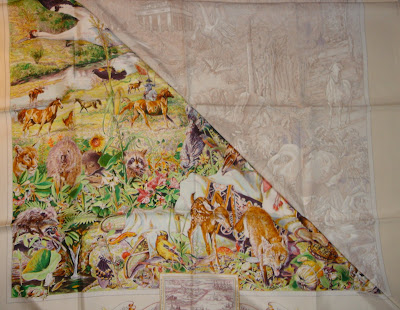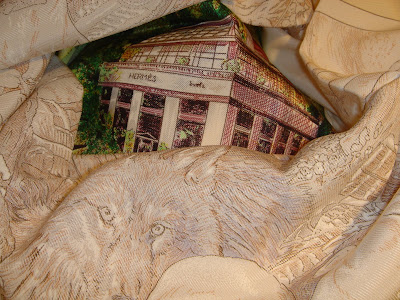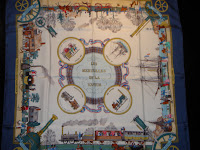

One of the most classic and timeless pieces ever done by the design house of Hermes is Napoleon. First issued in 1963, it was later re-issued in the years 1985, 1995, and 2002. The design was done by Phillipe Ledoux one of the most prolific designers of Hermes scarves in their history. No collection would be complete without a Ledoux design, as he is perhaps the most beloved of all designers by Hermes. I am not speaking regarding collectors, I am speaking regarding representatives of Hermes, they speak regarding the works of Ledoux with a reverence that they seem to rarely give others. Monsieur Ledoux has long since past, but his designs will live on forever.
Many collectors I know prefer their Napoleon scarves in the colorway that best represents France, such as the colors of the flag. I however, prefer the soft elegance suggested in soft pink border, perhaps giving the suggestion of the memory of Josephine.
The original Napoleon was produced with a bee jacquard as seen here. Hermes no longer produces Jacquards as they proved to be very expensive to produce.
Napoleon's BeesWilliam Henry Ireland in 1822 wrote:
"It was custom in France during its early and barbarous ages, that whenever a monarch died his horse and page were killed and buried with their master, that they might be in ready attendance upon him in the next world. In the year 1653, the tomb of Childeric, the father of Clovis was discovered and within it were found the skeleton of a man that of a horse and part of he skeleton of a youth, concluded to be the remains of Childeric and his companions. On furhter search in the tomb were found a purse, containing above a hundred pieces of gold and two hundred pieces of silver, bearing the heads of different emperors of France; a crystal ball or orb, a pike, a battleaxe, the handle, mounting and blade of a sword; gold tablets and style; the bit and part of the harness of a horse; fragments of dress or robe; and more than three hundred little bees of the purest gold, their wings being inlaid with red stone like carnelian. The appropriation of this emblem was hence suggested to Napoleon. A gold signet ring was taken from the finger of the larger skeleton; upon it appeared and engraved head, having long hair flowing over the shoulders, and it the words, "Childerici Regis"..."
"The State Council followed Cambacérès and Lacuée, who proposed the bees, as "a republic with a chief", with a sting but producing honey, which was the emblem of work for Ségur. The team, directed by Vivant Denon, that designed the imperial arms, proposed a semy of bees in "Merovingian style" on the imperial purple coat. The original design was deemed "too archaic". Later, a bee with well-detached wings was selected, and appeared on the Emperor and Emperess' clothes, as well as on the hanging in the Notre-Dame cathedral during the coronation.The bee was part of the French symbolic from 1804 to 1814 (First Empire), during the Cent-Jours (20/03-22/06/1815), and finally under Napoleon III's Second Empire (1852-1870)."
Source: Encyclopaedia Universalis
Below is a picture of the Merovingian Bees from the Gallica web site

I am fascinated by the pure luxury of the Hermes Napoleon Scarf, it seems to carry with its name a since of the decorum of the era it represents. I thought it would be interesting to do a photographic study of the scarf, a kind of visual meditation of it. Letting my camera be my eyes as it swirled the twill of bees. Below is the result of that meditation. I hope you enjoy the journey as much as I did.














































































